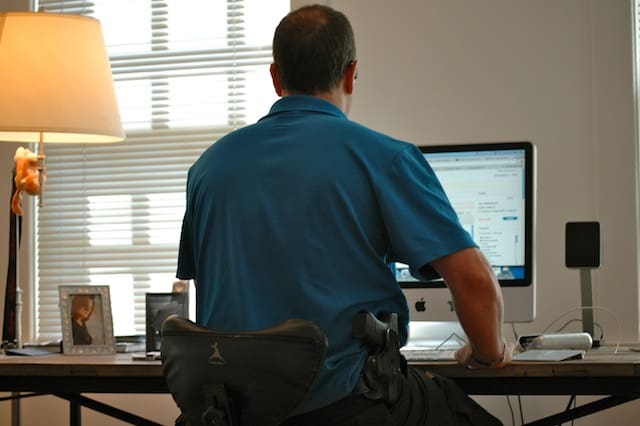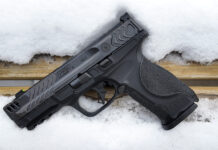
I’m a police FTO (Field Training Officer). Before trainees arrive on my patch, they receive rigorous firearms training at the Police Academy (insert joke here). For one week, for 10 hours a day, they hear the same thing: “On the line, from the holster, two rounds. Two rounds. READY, FIRE!” After following the command, they re-holster. And then repeat the drill, shooting at various distances with more or less rounds. The resulting draw is as automatic as clockwork. Uh-oh . . .
For most recruits, drawing your gun from a standing position is Standard Operating Procedure (SOP). In reality, a cop may have to shoot from any position short of the more advanced contortions found in the Kama Sutra (and maybe even those too). Drilling down (so to speak), there’s a high chance they’re going to have to shooting while sitting down.
Police officers are sitting ducks. They can’t anticipate every threat when sitting in their patrol car—especially in urban environments. Remember the Detroit cop shop shooting? Say what you will about cops and donuts, police officers are also vulnerable when sitting at the table of their favorite calorie intake establishment. And how many times are police knocked to the ground in combat?
In short, when it comes to shooting from a seated position, a police officer can’t get enough training. The police academy I attended had an outside shooting area set up like a restaurant. Shoot-don’t-shoot targets would pop up at various ranges. The training was awesome. And it was the last seated shooting training I ever received.
When I’ve got a trainee with me during FTO, we park our patrol vehicle in a safe location and make the gun safe. I then teach the officer how to draw his or her gun. Over and over. We vary the scenarios, from a traffic stop to a suspect approaching to a distant gun battle.
Shooting is the easy part. Mastering the art of drawing a gun smoothly from a chair or car seat and bring it to bear using your sights is the real challenge. So . . . practice. It’s a skill that may well save your life.




rigorous firearms training at the Police Academy (insert joke here)
I never joke about anything involving the great Officer Eugene Tackleberry 😀
Seriously though, I remember when our instructor at the SO first had us on the ground drawing and firing from a sitting position as well as from being on our backs. It was a little nerve wracking (no one wants to shoot their own foot off), but it makes sense to practice. If you have never practiced getting your sidearm out while in a “non standard” range position then awkwardly trying to figure it out while in a deadly encounter could have some seriously negative consequences.
The funny thing is when we bought our new AR’s and quilified, we shot from different angles.
Don’t forget to practice not shooting.
Bianchi makes (or used to make) a horizontal crossdraw holster called the ‘Chauffeur,’ specifically designed for use while seated or driving. Unfortunately it was completely useless, even unsafe, as soon as you stood up.
Crossdraws and shoulder rigs are better for seated use, but worse for
Chris: … but worse for …
Don’t leave me hanging, bro’.
…just about everything else?
(Don’t know how I managed to screw that up…)
I don’t know about that, now.
I personally like shoulder rigs, as they allow
easier access in a variety of positions,
and help to conceal larger handguns.
They are comfortable, to me, especially when
the weight of the handgun is balanced out with
some extra ammunition and mabye a knife,
a baton, or a flashlight.
Yes, they mean that you will need a cover garment,
and thus are not convienant in hot weather,
but you can own more than one holster.
We refer to our firearms as tools, and say that
we should use the right tool for the job.
Should holsters be any diffrent ?
“we park our patrol vehicle in a safe location”
The cops around here do the same thing. All day. Sometimes without a hooker.
Sounds like Renton PD lol
Good article Chris. I’m curious. Is your draw motion different when seated?
Slightly, only because I have to shift to one side and lean, im a lefty so to my right.
With a paddle holster, such as a Fobus, it is easy to shift the holster to a cross draw position if you are going to be spending a lot of time in a vehicle. An advantage of the cross draw position is that the pistol can be drawn fairly easily with either hand.
I have not owned a strap on thigh rig but they look like they would be good for cops on patrol for this very reason. Hard to conceal but if you are a uniform cop that is not a problem. I bet that 80% of the average cop’s time is spent sitting.
I have a son who is a TAC-P in the Air Force. He has several of the thigh rigs and he says they are great for use with body armor and for car draw but they stick out, catch on everything, make it difficult to walk through a brushy area, but are great for the seated draw. Some of his fellow warriors are using a cross-draw rig that hooks onto the body armor. It is bulky but it does not catch on brush and it can be drawn from the seated position. The hip holster is out of the question for these guys. To hard to get to with armor on. Obviously they don’t worry about concealment.
After the Seattle cop killings that have happened in the past year and a half (a half dozen cops killed, all seated, and none who got a shot off) I thought we would see a shift coming away from the hip holster. Perhaps we will.
I havent seen any shift in training regarding holster placement. It’s still the typcial high or low rise from the hip. I still only see it on tacitcal units and K9 units with regards to leg holsters. Some police departments use to have officers carry their tasers in a leg holster right under your handgun unitl they came up with the cross draw. It was a very dangerous situation and confusing to officers when it came to drawing their taser.
The one negative I find with the thigh-rig is a limit on mobility when crouched.
Comments are closed.